THE CORRELATION BETWEEN STUDENTS’ LISTENING MOTIVATION, VOCABULARY MASTERY AND SPEAKING ABILITY
DOI:
https://doi.org/10.26618/exposure.v8i1.2021Keywords:
correlation, listening, motivation, vocabulary, speakingAbstract
Purpose of this research is to know the correlation between the students’ Listening Motivation, Vocabulary Mastery, and Speaking ability. The methodology used is in correlation design by using a quantitative method. The data collecting technique is giving the questionnaire, test, and interview. The data analyzing technique used the correlation of product moment formula to measure the variables. The research findings indicate that there is a significant correlation between students listening motivation, vocabulary mastery, and speaking ability. It was proved by the value of ryx was greater than r table. The correlation between X1 - Y (ryx1) has a value is 0.98, the correlation between X2 - Y (ryx2) has a value is 0.99, the correlation between X1 - X2 (rx1x2) has a value is 0.97, and the correlation between X1 - X2 - Y (rx1x2y) has a value is 0.99. It means that have very high reliability.
References
Brown, Douglas. (2001). Teaching by Principle. Pearson Education, Inc.
Brown, D. H. 1976. Principles of Language Learning and Teaching: 2nd Edition. Eaglewood Cliffs: N.J. Prenctice-Hall Regents.
Cameron, L. 2001. Teaching languages to young learners. Cambridge: Cambridge University Press.
Chastain, K. (1971). The Development of Modern Language Skills: Theory to Practice. Philadelphia: Center for Curriculum Development.
Cross, D.1998. Teach English. Oxford: Oxford University Press
Cullen, B. 1998. Music and song in discussion. The Internet TESL Journal 4 (10). http://iteslj.org/ Techniques/Cullen-Music.html
——. 1999. Song dictation. The Internet TESL Journal 5 (11). http://iteslj.org/Techniques/ Cullen-SongDictation.html
Grauberg, Walter. 1997. The Elements of Foreign Language Teaching. Clevedon: Multilingual Matters, Ltd.
Harmer, Jeremy. 1998. How to Teach Language: An Introduction to the Practice of English Language Teaching. Addison Wesley Longman Limited.
Harmer, Jeremy. (2007). How to Teach English. Edinburg. Longman.
Hornby, A.S. 2002. Oxford Advanced Learners Dictionary of Current English. Britain: Oxford University Press.
Jackson,H and Amvela,E. 2000 Words, meaning and Vocabulary (An Introduction to Modern English Lexicology),London: Continuum
Kayi, Hayriye. 2006. Teaching Speaking: Activities to Promote Speaking in a Second Language. University of Nevada. The Internet TESL Journal, Vol. XII, No. 11, November 2006.
Kurniawati ,Yeni . 2013. The Correlation among Simple Past Tense Mastery, Vocabulary Mastery and Writing Ability of Students in Junior High School State 1 Metro Academic Year 2012/2013. Metro : Undergraduate program UM Metro
Littlewood, William. 1981. Communicative Language Teaching: An Introduction. Cambridge: Cambridge University Press.
Mulyaningsih,Reni. 2013.The Correlation between Vocabulary Mastery and Writing Recount Text Ability of Students’ at SMAN 5 Metro Academic Year 2012/203. Metro: Undergraduate program UM Metro
Nunan, D. (1992). Designing Tasks for the Communicative Classroom. Cambridge: Cambridge University Press.
Nunan, David. 2003. Practical English Language Teaching. NY:McGraw-Hill.
Nation, I. S. P. 1995. Teaching Listening and Speaking. English Language Institute Occasional Publication No. 14
Postovsky, V. A. 1975. On Paradoxes in Foreign Language Teaching. Modern Language Journal, 59(1), 18-21.
Purdy, M. 1997. What is Listening? In M. Purdy, & D. Borisoff (Eds.), Listening in Everyday Life. A Personal and Professional Approach. Lanham, MD: University Press of America
Richards, J. C., and Rodgers, T. S. 2001. Approaches and methods in language teaching. (2nd ed.). Cambridge: Cambridge University Press.
Thronbury, Scott. 2005. How to Teach Speaking. Longman.
Underwood, M. 1989. Teaching listening. London: Longman.
Downloads
Published
Issue
Section
License
Authors who publish with this journal agree to the following terms:
In order to assure the highest standards for published articles, a peer review policy is applied. In pursue of the compliance with academic standards, all parties involved in the publishing process (the authors, the editors and the editorial board and the reviewers) agree to meet the responsibilities stated below in accordance to the Journal publication ethics and malpractice statement.
Duties of Authors:
- The author(s) warrant that the submitted article is an original work, which has not been previously published, and that they have obtained an agreement from any co-author(s) prior to the manuscript’s submission;
- The author(s) should not submit articles describing essentially the same research to more than one journal;
- The authors(s) make certain that the manuscript meets the terms of the Manuscript Submission Guideline regarding appropriate academic citation and that no copyright infringement occurs;
- The authors(s) should inform the editors about any conflict of interests and report any errors they subsequently, discover in their manuscript.
Duties of Editors and the Editorial Board:
- The editors, together with the editorial board, are responsible for deciding upon the publication or rejection of the submitted manuscripts based only on their originality, significance, and relevance to the domains of the journal;
- The editors evaluate the manuscripts compliance with academic criteria, the domains of the journal and the guidelines;
- The editors must at all times respect the confidentiality of any information pertaining to the submitted manuscripts;
- The editors assign the review of each manuscript to two reviewers chosen according to their domains of expertise. The editors must take into account any conflict of interest reported by the authors and the reviewers.
- The editors must ensure that the comments and recommendations of the reviewers are sent to the author(s) in due time and that the manuscripts are returned to the editors, who take the final decision to publish them or not.
Authors are permitted and encouraged to post online a pre-publication manuscript (but not the Publisher’s final formatted PDF version of the Work) in institutional repositories or on their Websites prior to and during the submission process, as it can lead to productive exchanges, as well as earlier and greater citation of published work (see The Effect of Open Access). Any such posting made before acceptance and publication of the Work shall be updated upon publication to include a reference to the Publisher-assigned DOI (Digital Object Identifier) and a link to the online abstract for the final published Work in the Journal.

